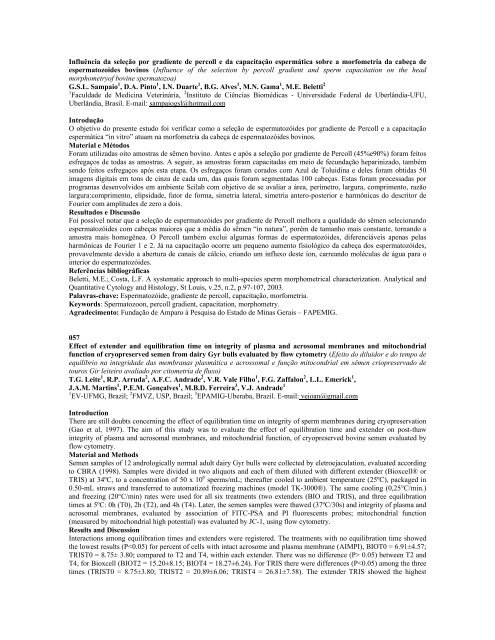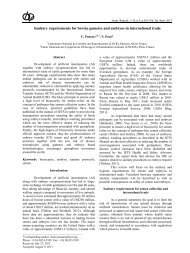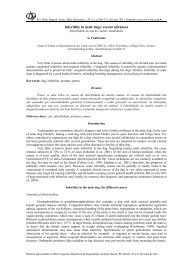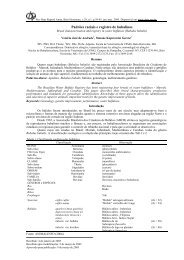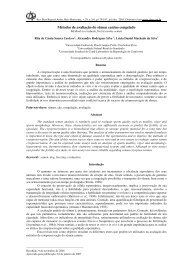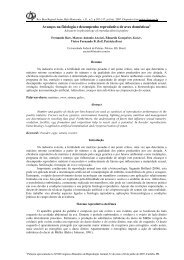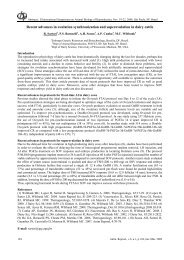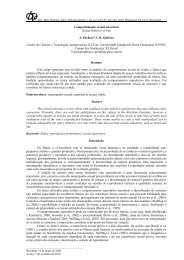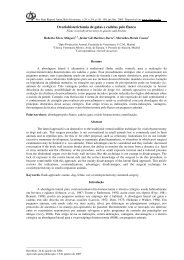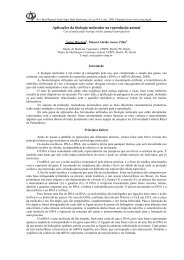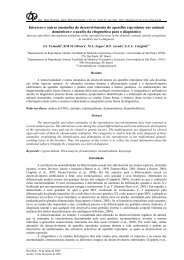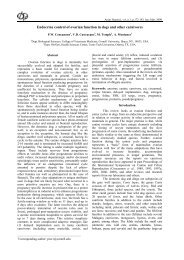Resumos apresentados pelos autores durante a Sessão de Posters ...
Resumos apresentados pelos autores durante a Sessão de Posters ...
Resumos apresentados pelos autores durante a Sessão de Posters ...
Create successful ePaper yourself
Turn your PDF publications into a flip-book with our unique Google optimized e-Paper software.
Influência da seleção por gradiente <strong>de</strong> percoll e da capacitação espermática sobre a morfometria da cabeça <strong>de</strong><br />
espermatozoi<strong>de</strong>s bovinos (Influence of the selection by percoll gradient and sperm capacitation on the head<br />
morphometryof bovine spermatozoa)<br />
G.S.L. Sampaio 1 , D.A. Pinto 1 , I.N. Duarte 1 , B.G. Alves 1 , M.N. Gama 1 , M.E. Beletti 2<br />
1 Faculda<strong>de</strong> <strong>de</strong> Medicina Veterinária, 2 Instituto <strong>de</strong> Ciências Biomédicas - Universida<strong>de</strong> Fe<strong>de</strong>ral <strong>de</strong> Uberlândia-UFU,<br />
Uberlândia, Brasil. E-mail: sampaiogsl@hotmail.com<br />
Introdução<br />
O objetivo do presente estudo foi verificar como a seleção <strong>de</strong> espermatozói<strong>de</strong>s por gradiente <strong>de</strong> Percoll e a capacitação<br />
espermática “in vitro” atuam na morfometria da cabeça <strong>de</strong> espermatozói<strong>de</strong>s bovinos.<br />
Material e Métodos<br />
Foram utilizadas oito amostras <strong>de</strong> sêmen bovino. Antes e após a seleção por gradiente <strong>de</strong> Percoll (45%e90%) foram feitos<br />
esfregaços <strong>de</strong> todas as amostras. A seguir, as amostras foram capacitadas em meio <strong>de</strong> fecundação heparinizado, também<br />
sendo feitos esfregaços após esta etapa. Os esfregaços foram corados com Azul <strong>de</strong> Toluidina e <strong>de</strong>les foram obtidas 50<br />
imagens digitais em tons <strong>de</strong> cinza <strong>de</strong> cada um, das quais foram segmentadas 100 cabeças. Estas foram processadas por<br />
programas <strong>de</strong>senvolvidos em ambiente Scilab com objetivo <strong>de</strong> se avaliar a área, perímetro, largura, comprimento, razão<br />
largura:comprimento, elipsida<strong>de</strong>, fator <strong>de</strong> forma, simetria lateral, simetria antero-posterior e harmônicas do <strong>de</strong>scritor <strong>de</strong><br />
Fourier com amplitu<strong>de</strong>s <strong>de</strong> zero a dois.<br />
Resultados e Discussão<br />
Foi possível notar que a seleção <strong>de</strong> espermatozói<strong>de</strong>s por gradiente <strong>de</strong> Percoll melhora a qualida<strong>de</strong> do sêmen selecionando<br />
espermatozói<strong>de</strong>s com cabeças maiores que a média do sêmen “in natura”, porém <strong>de</strong> tamanho mais constante, tornando a<br />
amostra mais homogênea. O Percoll também exclui algumas formas <strong>de</strong> espermatozói<strong>de</strong>s, diferenciáveis apenas pelas<br />
harmônicas <strong>de</strong> Fourier 1 e 2. Já na capacitação ocorre um pequeno aumento fisiológico da cabeça dos espermatozói<strong>de</strong>s,<br />
provavelmente <strong>de</strong>vido a abertura <strong>de</strong> canais <strong>de</strong> cálcio, criando um influxo <strong>de</strong>ste íon, carreando moléculas <strong>de</strong> água para o<br />
interior do espermatozói<strong>de</strong>s.<br />
Referências bibliográficas<br />
Beletti, M.E.; Costa, L.F. A systematic approach to multi-species sperm morphometrical characterization. Analytical and<br />
Quantitative Cytology and Histology, St Louis, v.25, n.2, p.97-107, 2003.<br />
Palavras-chave: Espermatozói<strong>de</strong>, gradiente <strong>de</strong> percoll, capacitação, morfometria.<br />
Keywords: Spermatozoon, percoll gradient, capacitation, morphometry.<br />
Agra<strong>de</strong>cimento: Fundação <strong>de</strong> Amparo à Pesquisa do Estado <strong>de</strong> Minas Gerais – FAPEMIG.<br />
057<br />
Effect of exten<strong>de</strong>r and equilibration time on integrity of plasma and acrosomal membranes and mitochondrial<br />
function of cryopreserved semen from dairy Gyr bulls evaluated by flow cytometry (Efeito do diluidor e do tempo <strong>de</strong><br />
equilíbrio na integrida<strong>de</strong> das membranas plasmática e acrossomal e função mitocondrial em sêmen criopreservado <strong>de</strong><br />
touros Gir leiteiro avaliado por citometria <strong>de</strong> fluxo)<br />
T.G. Leite 1 , R.P. Arruda 2 , A.F.C. Andra<strong>de</strong> 2 , V.R. Vale Filho 1 , F.G. Zaffalon 2 , L.L. Emerick 1 ,<br />
J.A.M. Martins 1 , P.E.M. Gonçalves 1 , M.B.D. Ferreira 3 , V.J. Andra<strong>de</strong> 1<br />
1 EV-UFMG, Brazil; 2 FMVZ, USP, Brazil; 3 EPAMIG-Uberaba, Brazil. E-mail: vejoan@gmail.com<br />
Introduction<br />
There are still doubts concerning the effect of equilibration time on integrity of sperm membranes during cryopreservation<br />
(Gao et al, 1997). The aim of this study was to evaluate the effect of equilibration time and exten<strong>de</strong>r on post-thaw<br />
integrity of plasma and acrosomal membranes, and mitochondrial function, of cryopreserved bovine semen evaluated by<br />
flow cytometry.<br />
Material and Methods<br />
Semen samples of 12 andrologically normal adult dairy Gyr bulls were collected by eletroejaculation, evaluated according<br />
to CBRA (1998). Samples were divi<strong>de</strong>d in two aliquots and each of them diluted with different exten<strong>de</strong>r (Bioxcell® or<br />
TRIS) at 34ºC, to a concentration of 50 x 10 6 sperms/mL; thereafter cooled to ambient temperature (25ºC), packaged in<br />
0.50-mL straws and transferred to automatized freezing machines (mo<strong>de</strong>l TK-3000®). The same cooling (0,25°C/min.)<br />
and freezing (20°C/min) rates were used for all six treatments (two exten<strong>de</strong>rs (BIO and TRIS), and three equilibration<br />
times at 5ºC: 0h (T0), 2h (T2), and 4h (T4). Later, the semen samples were thawed (37ºC/30s) and integrity of plasma and<br />
acrosomal membranes, evaluated by association of FITC-PSA and PI fluorescents probes; mitochondrial function<br />
(measured by mitochondrial high potential) was evaluated by JC-1, using flow cytometry.<br />
Results and Discussion<br />
Interactions among equilibration times and exten<strong>de</strong>rs were registered. The treatments with no equilibration time showed<br />
the lowest results (P 0.05) between T2 and<br />
T4, for Bioxcell (BIOT2 = 15.20±8.15; BIOT4 = 18.27±6.24). For TRIS there were differences (P


